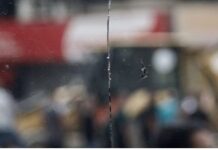Tareq S. Hajjaj
Mondoweiss / April 27, 2023
With population density reaching an all-time high in Gaza, people spend their life savings to secure homes for their families, only to have them wiped out by Israeli airstrikes. In Gaza, no place is safe.
The way families in Gaza live has changed dramatically over the years, a reflection of the effect that shifting circumstances and time have had on generations and how they adapt to survive. An old-fashioned Gaza family would typically grow by building houses next to the old ones, expanding horizontally over the years as families swelled in size and children grew up, married, and had children of their own. Today, the new model sees people in Gaza living on top of one another, because there’s nowhere left to build.
Many consider themselves lucky to ever be able to build new stories on top of their family homes, but people who find themselves in those circumstances are far fewer today than they were years ago. Most families are too big to be able to expand within their own properties; where often more than four brothers share a building, each with his own family on a separate floor, each of those families will eventually outgrow their space, especially when their children aim to start families of their own. At first, they might build one more floor above the family building. But eventually, most choose to find a new place. When they start on this course, an endless journey of uncertainty regarding finding a safe place to live ensues.
Abed Nusrat is a 33-year-old independent trader. He has been renting a shop for over ten years now. Aside from helping his family and supporting his sisters’ education, his past decade’s work in trading has allowed him to pay 20% of the cost of a new home, where he plans to start a family. Located in the eastern part of the Shuja’iyya neighborhood, east of Gaza City, Abed’s home and the homes of people in that area are the first to be targeted by Israeli bombing during heightened tensions or wars. The people of the area are also the first to flee the bombardment, posing a permanent hazard for the residents of al-Shuja’iyya.
Buying land and building your own house has become virtually impossible for the 81.8% of Palestinians living in Gaza who, according to the UN, live below the poverty line, requiring decades of hard work and savings. The far more realistic option has been to get a small apartment in a residential tower — that is, before Israeli warplanes made those towers prime targets of its bombing campaigns.
“I fled my home many times,” Abed Nusrat said. “Even when we thought that we lived in a residential building in central Gaza like the al-Rimal neighborhood, we would still be harmed whenever a nearby collapsing building would fall onto the building where we would be taking shelter, forcing us to flee all over again.”
These experiences made Abed reluctant to settle in any one place whenever he thought of starting a family. He and his family are currently living with his father’s family in the same apartment as he attempts to find a place of his own. But Abed is also faced with a dilemma, as he is one of the few Gaza residents who was offered the opportunity of building a floor on top of his father’s apartment in the same building, which is now five floors high. But Abed isn’t encouraged to take the opportunity and would prefer to remain in the apartment with his father’s family for now until he’s able to find a place in a residential tower in a safer area. However, safety isn’t the only consideration.
At times, he is left wondering what difference it would make to stay away from the border areas. “You can clearly see that no place is safe as long as it’s inside the Gaza Strip,” he said. “At any minute, your home can be destroyed in the blink of an eye by Israeli warplanes, and maybe your family dies too.”
Yet he is adamant about moving from al-Shuja’iyya. “I am lucky that my father has provided me with a home, it’s the best he can do to provide for his children,” he acknowledges. “But I want to be able to do the same for my family, and I want my kids to be able to say the same thing about me, that their father provided them with a home, even though my father spent his entire life trying to provide us with this home.”
No place is safe
During the past wars on Gaza, thousands of residential units were destroyed. The residential towers housing those homes received the lion’s share of the bombardment and destruction. For people who are looking to start a family and find jobs to pay off their debts, the only option available to them is to buy an apartment in a tower and spend the next 20 years paying for it. As if the burden of debt wasn’t enough, the prospect that a person’s home could be wiped out instantly, a home into which they have poured decades of hard work, has become a real possibility. Many have already suffered this fate.
Over the years of successive wars and Israeli shelling, people in Gaza have begun to shift how they lived and built their homes, to the point that people have been pushed to abandon their lands located next to the borders from fear of bombardment. All the while, the population of over 2.5 million people in the Gaza Strip’s besieged 365 square kilometers continues to grow, and as the demand for land and property increases, so do the prices.
“The high cost of land in Gaza amid the deteriorating economic situation brought on by the siege has prevented people from establishing separate houses on their own lands,” Hussam Salem, an architect at the Center for Engineering and Planning in Gaza, told Mondoweiss.
Salem explains that there are places in Gaza where you can’t find any place to build a home, like in the northern Gaza Strip, where refugee camps like Jabaliya are located. The population density in that area has reached its maximum capacity, rendering finding land for new construction impossible, so people end up building on top of each other. At the same time, that solution has also become daunting in the face of Israeli airstrikes, putting Gaza residents between a rock and a hard place.
“The wars of 2014 and 2021 gave rise to new fears of living in residential buildings and towers,” Salem said. “The institution I work for used to be located in the al-Jawharah tower, but Israel destroyed it in the 2014 war.”
This means that the new priority of homeowners in Gaza is safety, but the indiscriminate nature of Israeli attacks makes the quest to find safe areas to live increasingly illusory. Many people like Abed have therefore concluded that no place is safe.
“I was sitting with my family when we all saw the tower falling down on our apartment in the building next door,” Nabil Ali, a resident of a Gaza tower whose home was critically damaged during a bombardment, told Mondoweiss. “But we have no other place to go to, this is our house.”
“It’s not a safe place to live, you could lose your life at any minute,” he continued. “But I don’t only feel this about my home. I feel this about anywhere in Gaza.”
Throughout the course of Israel’s four wars on Gaza, launched between 2008 and 2022, Israel has destroyed or partially damaged 17,400 homes and has critically damaged over 40,000 housing units. The Israeli air forces also directly targeted over 11 residential towers during the recent two wars, leaving hundreds of residents homeless.
Ali is 48 years old and a father to three sons and one daughter. He is a civil employee, and the damaged apartment he lives in is all he owns. For now, his children are still kids, and they can all live together, but in the near future, his three boys will need to start families of their own, and the prospect of finding all of them homes has become daunting.
“Without even getting into the difficulties I faced in finding a house for my family, I ask myself what my children will do in the future when they want to secure homes for their own families,” he said, pointing to his children.
To be able to afford his apartment, Ali took out a bank loan that he will have to continue to pay off for the next 25 years, and since he is a government employee, the monthly mortgage payment is directly deducted from his monthly salary.
With all their life savings pooled into securing these homes, people are left wondering whether it’s worth the risk if they might be left homeless in the blink of an eye. All it takes is an indiscriminate airstrike, and all their hard work is wiped out.
“I will live most of my life paying back the price of my home,” Ali said. “Do I feel safe and secure?”
Somberly, he reflects: “As long as the Israelis are occupying our lands, they will continue to bomb us and make us homeless.”
Tareq S. Hajjaj is the Mondoweiss Gaza Correspondent and a member of the Palestinian Writers Union












